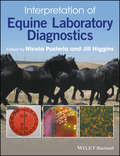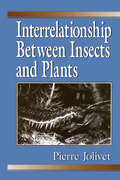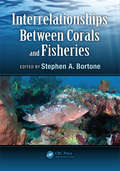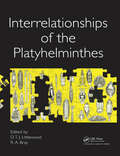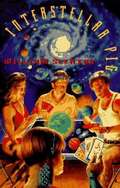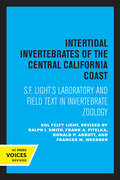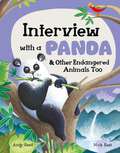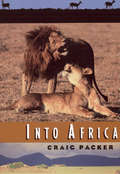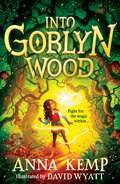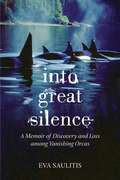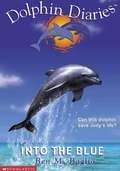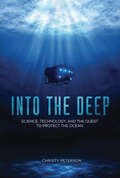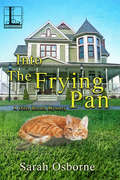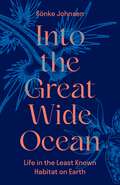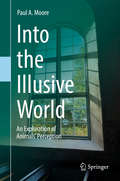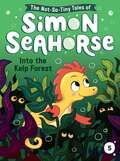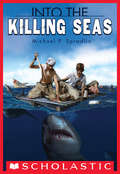- Table View
- List View
Internet Guide to Pet Health
by Elizabeth ConnorWith the staggering amount of pet health information available on the Internet, it is often difficult to find exactly what you are looking for. The Internet Guide to Pet Health is a one-stop guide that weeds through all the clutter to bring you only the most dependable sources and relevant content. This comprehensive compilation of annotated links will serve as a handy, useful, and easy-to-consult guide for persons who appreciate animals and/or own domestic pets of all kinds, especially cats and dogs. This text also features a full glossary of medical terms, bibliography, and a quick-find index.The health needs of pet animals have become as complex and specialized as those of humans. Pet owners, veterinarians, and animal lovers alike need authoritative, reliable, and up-to-date information about caring for the health and well-being of pets. The Internet Guide to Pet Health offers a quick, easy, and comprehensive reference to quality Web sites that focus on the health and welfare of animal companions. The Internet Guide to Pet Health will help you pinpoint reliable information on: • the health benefits of pet ownership • diseases transmitted by pets • pet food safety • animal care and welfare societies and organizations • death, dying, and euthanasia • poisons, dangerous situations, and other hazards • spaying and neutering • traveling with pets • pet-specific care for dogs, cats, small animals, and fish • surgery, surgical procedures, and hospitalization • exercise and training • dental care, diet, and nutrition • disabled pets • service and therapy animals • and much, much more! The Internet Guide to Pet Health is an ideal resource for anyone who is directly involved in the lives of pet companions or simply an animal lover. Medical librarians in academic medical centers and teaching hospitals; consumer health and public librarians; veterinarians and veterinary clinic staff; public health personnel; animal trainers; and groomers will also find this to be an invaluable text.
Interpretation of Equine Laboratory Diagnostics
by Nicola Pusterla Jill HigginsInterpretation of Equine Laboratory Diagnostics offers a comprehensive approach to equine laboratory diagnostics, including hematology, clinical chemistry, serology, body fluid analysis, microbiology, clinical parasitology, endocrinology, immunology, and molecular diagnostics. Offers a practical resource for the accurate interpretation of laboratory results, with examples showing real-world applications Covers hematology, clinical chemistry, serology, body fluid analysis, microbiology, clinical parasitology, endocrinology, immunology, and molecular diagnostics Introduces the underlying principles of laboratory diagnostics Provides clinically oriented guidance on performing and interpreting laboratory tests Presents a complete reference to establish and new diagnostic procedures Offers a practical resource for the accurate interpretation of laboratory results, with examples showing real-world applications Covers hematology, clinical chemistry, serology, body fluid analysis, microbiology, clinical parasitology, endocrinology, immunology, and molecular diagnostics Introduces the underlying principles of laboratory diagnostics Provides clinically oriented guidance on performing and interpreting laboratory tests Presents a complete reference to established and new diagnostic procedures
Interrelationship Between Insects and Plants
by Pierre JolivetOne of the world's most insightful writers on the subject brings together an array of important and readable information on the ways in which insects and plants coexist in nature. Interrelationship Between Insects and Plants is a rare and expansive look at the intertwining of these two vastly different species. Its aim is to summarize in a simple a
Interrelationships Between Corals and Fisheries
by Stephen A. BortoneInterrelationships Between Corals and Fisheries is derived from a workshop held by the Gulf of Mexico Fishery Management Council in Tampa, Florida in May 2013, where world authorities came together to discuss the current problems in managing tropical fisheries and offered suggestions for future directions for both researchers and environmental reso
Interrelationships of the Platyhelminthes
by D. T. J. Littlewood R. A. BrayInterrelationships of the Platyhelminthes elucidates the role of the flatworms in the animal kingdom. It brings together results from an international group of experts, spanning many disciplines, who give evidence for the phylogeny of flatworms and constituent major taxa. A combined approach, using traditional comparative techniques along with the modern techniques of molecular phylogeny, is utilized to show that the monophyly of the phylum is not fully established, and that the phylum may in fact consist of two groups: the acoels and their relatives, which are basal metazoans, and the Rhabditophora, which is a more derived group.
Interrupting Chicken
by David Ezra SteinIt's bedtime for the little red chicken, and papa is going to read her a story. "You're not going to interrupt the story tonight, are you?" asks Papa. "Oh no, Papa. I'll be good," says the little red chicken. But she just can't help herself! Whether it's Hansel and Gretel, Little Red Riding Hood, or Chicken Little, as soon as the story gets going . . . out jumps the little red chicken--right into the story--saving the characters from danger and ending the story early. Will that chicken ever get to sleep?
Interrupting Chicken (Interrupting Chicken)
by David Ezra SteinLittle Red Chicken wants Papa to read her a bedtime story. but interrupts him almost as soon as he begins each tale.
Interspecies Ethics
by Cynthia WillettInterspecies Ethics explores animals' vast capacity for agency, justice, solidarity, humor, and communication across species.
Interspecies Ethics
by Cynthia WillettInterspecies Ethics explores animals' vast capacity for agency, justice, solidarity, humor, and communication across species.
Interspecies Ethics
by Cynthia WillettInterspecies Ethics explores animals' vast capacity for agency, justice, solidarity, humor, and communication across species.
Interspecies Ethics (Critical Perspectives on Animals: Theory, Culture, Science, and Law)
by Cynthia WillettInterspecies Ethics explores animals' vast capacity for agency, justice, solidarity, humor, and communication across species. The social bonds diverse animals form provide a remarkable model for communitarian justice and cosmopolitan peace, challenging the human exceptionalism that drives modern moral theory. Situating biosocial ethics firmly within coevolutionary processes, this volume has profound implications for work in social and political thought, contemporary pragmatism, Africana thought, and continental philosophy.Interspecies Ethics develops a communitarian model for multispecies ethics, rebalancing the overemphasis on competition in the original Darwinian paradigm by drawing out and stressing the cooperationist aspects of evolutionary theory through mutual aid. The book's ethical vision offers an alternative to utilitarian, deontological, and virtue ethics, building its argument through rich anecdotes and clear explanations of recent scientific discoveries regarding animals and their agency. Geared toward a general as well as a philosophical audience, the text illuminates a variety of theories and contrasting approaches, tracing the contours of a postmoral ethics.
Interstellar Pig
by William SleatorBarney's boring seaside vacation suddenly becomes more interesting when the cottage next door is occupied by three exotic neighbors who are addicted to a game they call "Interstellar Pig."
Intertidal Invertebrates of the Central California Coast: S.F. Light's Laboratory and Field Text in Invertebrate Zoology
by S. F. LightThis title is part of UC Press's Voices Revived program, which commemorates University of California Press’s mission to seek out and cultivate the brightest minds and give them voice, reach, and impact. Drawing on a backlist dating to 1893, Voices Revived makes high-quality, peer-reviewed scholarship accessible once again using print-on-demand technology. This title was originally published in 1954.
Interview with a Panda: And Other Endangered Animals Too (Interview with a… #4)
by Andy SeedIf you could talk to animals, what would you ask?Get familiar with 10 endangered animals as they step up to the mic and share their habits, behaviour, likes and dislikes, favourite foods, and more. Each animal has its own story to tell... and its own attitude!In this fun and fact-filled book, bite-sized text in a question-and-answer format is paired with colourful and engaging illustrations throughout, perfect for emerging or reluctant readers, or any young animal enthusiast who enjoys a bit of humour!Features 'interviews' with a giant panda, green turtle, black rhino, flying fox, Sumatran elephant, Cuban crocodile, tiger chameleon, kakapo and Western Nimba toad. Plus, ideas for how to do your bit to help endangered species.Look out for other titles in the series: Interview with a Tiger, Interview with a Shark, Interview with a Kangaroo!
Into Africa
by Craig PackerCraig Packer takes us into Africa for a journey of fifty-two days in the fall of 1991. But this is more than a tour of magnificent animals in an exotic, faraway place. A field biologist since 1972, Packer began his work studying primates at Gombe and then the lions of the Serengeti and the Ngorongoro Crater with his wife and colleague Anne Pusey. Here, he introduces us to the real world of fieldwork—initiating assistants to lion research in the Serengeti, helping a doctoral student collect data, collaborating with Jane Goodall on primate research. As in the works of George Schaller and Cynthia Moss, Packer transports us to life in the field. He is addicted to this land—to the beauty of a male lion striding across the Serengeti plains, to the calls of a baboon troop through the rain forests of Gombe—and to understanding the animals that inhabit it. Through his vivid narration, we feel the dust and the bumps of the Arusha Road, smell the rosemary in the air at lunchtime on a Serengeti verandah, and hear the lyrics of the Grateful Dead playing off bootlegged tapes.Into Africa also explores the social lives of the animals and the threats to their survival. Packer grapples with questions he has passionately tried to answer for more than two decades. Why do female lions raise their young in crèches? Why do male baboons move from troop to troop while male chimps band together? How can humans and animals continue to coexist in a world of diminishing resources? Immediate demands—logistical nightmares, political upheavals, physical exhaustion—yield to the larger inescapable issues of the interdependence of the land, the animals, and the people who inhabit it.
Into Africa: With a New Postscript
by Craig PackerCraig Packer takes us into Africa for a journey of fifty-two days in the fall of 1991. But this is more than a tour of magnificent animals in an exotic, faraway place. A field biologist since 1972, Packer began his work studying primates at Gombe and then the lions of the Serengeti and the Ngorongoro Crater with his wife and colleague Anne Pusey. Here, he introduces us to the real world of fieldwork—initiating assistants to lion research in the Serengeti, helping a doctoral student collect data, collaborating with Jane Goodall on primate research. As in the works of George Schaller and Cynthia Moss, Packer transports us to life in the field. He is addicted to this land—to the beauty of a male lion striding across the Serengeti plains, to the calls of a baboon troop through the rain forests of Gombe—and to understanding the animals that inhabit it. Through his vivid narration, we feel the dust and the bumps of the Arusha Road, smell the rosemary in the air at lunchtime on a Serengeti verandah, and hear the lyrics of the Grateful Dead playing off bootlegged tapes. Into Africa also explores the social lives of the animals and the threats to their survival. Packer grapples with questions he has passionately tried to answer for more than two decades. Why do female lions raise their young in crèches? Why do male baboons move from troop to troop while male chimps band together? How can humans and animals continue to coexist in a world of diminishing resources? Immediate demands—logistical nightmares, political upheavals, physical exhaustion—yield to the larger inescapable issues of the interdependence of the land, the animals, and the people who inhabit it.
Into Goblyn Wood (A Goblyn Wood Adventure #1)
by Anna KempFairies are real, but their power is waning . . . Embark on the adventure of a lifetime and discover the magic of Goblyn Wood, with the first book in a major new fantasy series for fans of Nevermoor and Podkin One-Ear!Are you ready to enter Goblyn Wood . . . ?Hazel has always known she was different, but she doesn&’t know where she came from. When her best friend Pete is kidnapped by strange creatures, she must gather her courage and enter Goblyn Wood, a forest inhabited by fairies. But their magic is being drained away, and Hazel soon realises that her own power is the key to saving both Pete and her new friends. Embarking on an epic journey of discovery, can Hazel restore the balance of the fairy realm?The debut fiction novel from Waterstones prize-shortlisted Anna Kemp – enter this rich and immersive new fantasy world and meet a powerful new hero.
Into Great Silence: A Memoir of Discovery and Loss among Vanishing Orcas
by Eva SaulitisScience entwines with matters of the human heart as a whale researcher chronicles the lives of an endangered family of orcas Ever since Eva Saulitis began her whale research in Alaska in the 1980s, she has been drawn deeply into the lives of a single extended family of endangered orcas struggling to survive in Prince William Sound. Over the course of a decades-long career spent observing and studying these whales, and eventually coming to know them as individuals, she has, sadly, witnessed the devastation wrought by the Exxon Valdez oil spill of 1989--after which not a single calf has been born to the group. With the intellectual rigor of a scientist and the heart of a poet, Saulitis gives voice to these vital yet vanishing survivors and the place they are so loyal to. Both an elegy for one orca family and a celebration of the entire species, Into Great Silence is a moving portrait of the interconnectedness of humans with animals and place--and of the responsibility we have to protect them.From the Hardcover edition.
Into the Blue (The Dolphin Diaries #1)
by Ben M. BaglioJody is about to begin the adventure of a lifetime. She and her family will be spending a year on a sailboat following, and watching dolphins. When Jody's life is saved by a wild dolphin, she forms her first dolphin friendship.
Into the Deep: Science, Technology, and the Quest to Protect the Ocean
by Christy PetersonContaining 97 percent of Earth's water supply, the ocean plays a huge role in regulating global temperatures, supporting plant and animal life, and contributing to the livelihoods of millions of people. But in spite of all this, the ocean remains drastically unexplored, and the details of its impact on human lives aren't fully understood. Scientists from around the world are realizing that to address issues plaguing the ocean, such as dead zones, coral bleaching, and climate change, we need to better understand this incredible, unique feature of our planet. With a range of impressive, cutting-edge technologies at their disposal, oceanographers have set out to measure, sample, and analyze at every turn. Every day, mysteries about the ocean are being solved, and every day, new questions come to light. The more scientists learn, the better they are able to answer these new questions. What lies in the deep? And who is at the forefront of these exciting discoveries? The scientists and research included in this book shed light on the most pressing issues currently facing oceanographers and point us in the right direction to solving these challenges.
Into the Frying Pan: A Southern Cozy Mystery Full of Country Cooking (A Ditie Brown Mystery #2)
by Sarah OsborneMabel Aphrodite Brown has quickly learned that motherhood can sometimes be a real skirmish. But when death visits a Civil War reenactment, it’s murder that’s a battlefield . . . In the thick of a hot, muggy Atlanta summer, all Ditie Brown wants to do is keep her kids occupied and get them ready for school in the fall. When her ex-boyfriend, Phil Brockton, shows up for a Civil War reenactment, she thinks it might be fun and educational for the kids. Plus, her best friend Lurleen wants to put on the costumes and get in on the action, and Ditie isn’t one to rebel. But things go south after a cannon misfires, resulting in the death of Phil’s med school rival. Was it an accident or something more sinister? Ditie soon realizes the past rarely stays buried, and her digging reveals longstanding enemies, killer motives, and new jealousy. When another reenactor is “accidentally” shot, the pressure is on for Ditie to solve the murders—or else her friends may be history . . . Includes Family-Friendly Recipes!
Into the Great Wide Ocean: Life in the Least Known Habitat on Earth
by Sönke JohnsenA seagoing scientist explores how life thrives in one of the most mysterious environments on EarthThe open ocean, far from the shore and miles above the seafloor, is a vast and formidable habitat that is home to the most abundant life on our planet, from giant squid and jellyfish to anglerfish with bioluminescent lures that draw prey into their toothy mouths. Into the Great Wide Ocean takes readers inside the peculiar world of the seagoing scientists who are providing tantalizing new insights into how the animals of the open ocean solve the problems of their existence.Sönke Johnsen vividly describes how life in the water column of the open sea contends with a host of environmental challenges, such as gravity, movement, the absence of light, pressure that could crush a truck, catching food while not becoming food, finding a mate, raising young, and forming communities. He interweaves stories about the joys and hardships of the scientists who explore this beautiful and mysterious realm, which is under threat from human activity and rapidly changing before our eyes.Into the Great Wide Ocean presents the sea and its inhabitants as you have never seen them before and reminds us that the rules of survival in the open ocean, though they may seem strange to us, are the primary rules of life on Earth.
Into the Illusive World: An Exploration of Animals’ Perception
by Paul A. MooreHave you ever thought about what a dog smells as it stops to sniff at a tree? Or what a cat is watching as it stares intensely off into space? What about animals in the wild? What do they see, hear, smell, and feel? How do they perceive their surroundings? This is the illusive world. A world filled with fascinating stimuli that we are not equipped to detect. This is particularly true because we tend to rely so heavily on our eyes or ears. We are figuratively, and literally, blind to this part of the natural world. This part, which is full of stimuli we cannot perceive, encompasses the daily lives of so many animals. Beneath our feet are ants, moles, and spiders using vibrations to coordinate colonies and communicate danger. In the oceans, turtles, fish, and octopi are sensitive to magnetic and electric fields, as well as tasty morsels at the tips of their tentacles. In the skies, owls and raptors can see deep into a lake or pierce the night with highly sensitive eyes. This book brings together all these animals and their amazing sensory abilities in an exploration of how animals perceive their world. Within these pages are wonderful and exciting stories of organisms using their senses to perform sophisticated communication with nestmates, find hidden prey in the dark of night or murky of depths, and call to lovers both near and far. This book will open the door to this illusive world and will take you on a journey into the illusive world and see how different the world is when perceived through another animal’s senses.
Into the Kelp Forest (The Not-So-Tiny Tales of Simon Seahorse #5)
by Cora ReefSimon tries to catch the mysterious Kelp Monster in this fifth book in The Not-So-Tiny Tales of Simon Seahorse chapter book series.Simon&’s friends are talking about the mysterious Kelp Monster at school one day and, for once, Simon doesn&’t have anything to add to the story! That&’s because he&’s never even heard of the Kelp Monster. But from what his friends say, it&’s bigger than a whale shark and its teeth are sharper than red-bellied piranha! And it lives in the Kelp Forest, where all the fish are scared of it. After all this talk, Simon decides he has a mission: to catch the kelp monster and find out why it&’s spooking the other sea creatures! But Simon&’s in for a big surprise about this so-called monster! With easy-to-read language and illustrations on almost every page, The Not-So-Tiny Tales of Simon Seahorse chapter books are perfect for emerging readers.
Into the Killing Seas
by Michael P. Spradlin"When the ship goes down, the sharks come out.... Stranded in the war torn Pacific, Patrick and his younger brother Teddy are finally homeward-bound. They've stowed away on one of the US Navy's finest ships, and now they just need to stay hidden. But Japanese torpedoes rip their dream apart. And the sinking ship isn't the worst of it. Patrick and Teddy can handle hunger and dehydration as they float in the water and wait to be rescued. If they're smart, they can even deal with the madness that seems to plague their fellow survivors. No, the real danger circles beneath the surface. And it has teeth.... Based on the true events of the 1945 sinking of the USS Indianapolis, author Michael P. Spradlin tells a harrowing story of World War II."

